The NWSL 2020 Challenge Cup brought us a Sky Blue team in the middle of drastic change. Manager Freya Coombe has overseen a transition in attacking style towards a more possession-based system in her few games in charge. Having joined the team in the 2020 offseason, Margeret Midge Purce has been seen as a major step towards Sky Blue’s new attacking tactics.
Through analysis, this scout report will delve into what kind of attacking player Sky Blue have in their ranks and whether or not she was used to full effect in the Challenge Cup. This tactical analysis will look at exactly what Purce can bring to Sky Blue.
Background
Purce advanced through her youth and college career as a striker. When entering the professional ranks, she began to see play time as a right-back as well. This comes from managers aiming to employ more aggressive attacking tactics by stashing attacking minded players in the outside back position. This allows teams to not only use forward and midfield players in attack, but also allocate players from the defensive line to create overloads on the flanks, penetrating overlaps or underlaps and late attacking runs into the attacking third.
1 vs 1 capability: What is she good at?
Purce’s ability in various 1 vs 1 situations makes her a liability to any opponent she comes against. She is able to use a combination of speed, agility, technical proficiency with all surfaces of the foot and attacking aggression to make herself an attacking force on the field.
This is reflected in her 2019 statistics with the Portland Thorns, having finished top ten in the league on the goal chart with 8 goals (0.51 per 90’). She also finished third in the league in touches in the penalty area with 5.78 per 90’. Both of those statistics can be said to stem from the fact that Purce ranked top five in the league in offensive duels with 14.07 per 90’.
Purce is able to successfully execute offensive duels from multiple angles of pressure. Whether the nearest defender approaches from the front, side or behind, Purce has the ability to win the duel and advance play for her team. These movements are performed not through flair or trick moves, but through simple change of speed and change of direction.
Her use of rapid change of speed and change of direction paired with the ability to use all parts of both feet make her quite hard to defend against. We can see a few examples of this below.
In a 2019 match against the Red Stars we see a moment in which Purce has received the ball with her back to the Red Stars goal. For the marking centre-back, this is ideal because their objective in this situation is typically to keep the attacker facing away from goal to prevent any forward penetration.
Purce is aware that there is plenty of space behind the defender to exploit, she just has to move the ball past the defender and penetrate forward.
We see that Purce has received the ball with her right foot. Typically, the attacking player will use their body to roll off the opponent and push into space behind. Instead, Purce opts to put her foot on top of the ball and uses her right foot to pull the ball back.
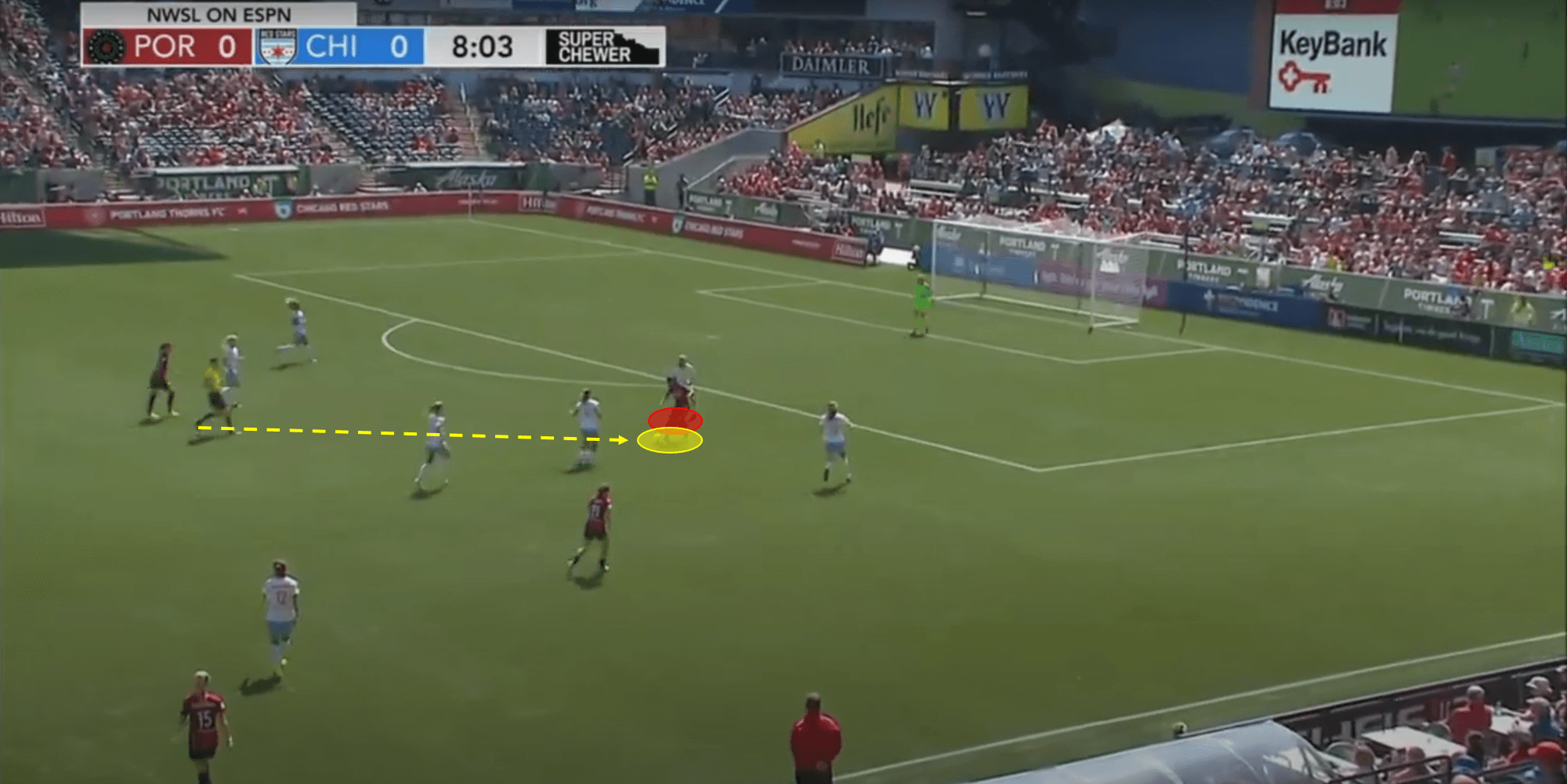
This movement opens up Purce’s body to the defender and allows the ball to be completely exposed to her marking opponent. As the ball is pulled backwards, Purce then uses the inside of her right foot to push the ball forward into space behind the Chicago defensive line.
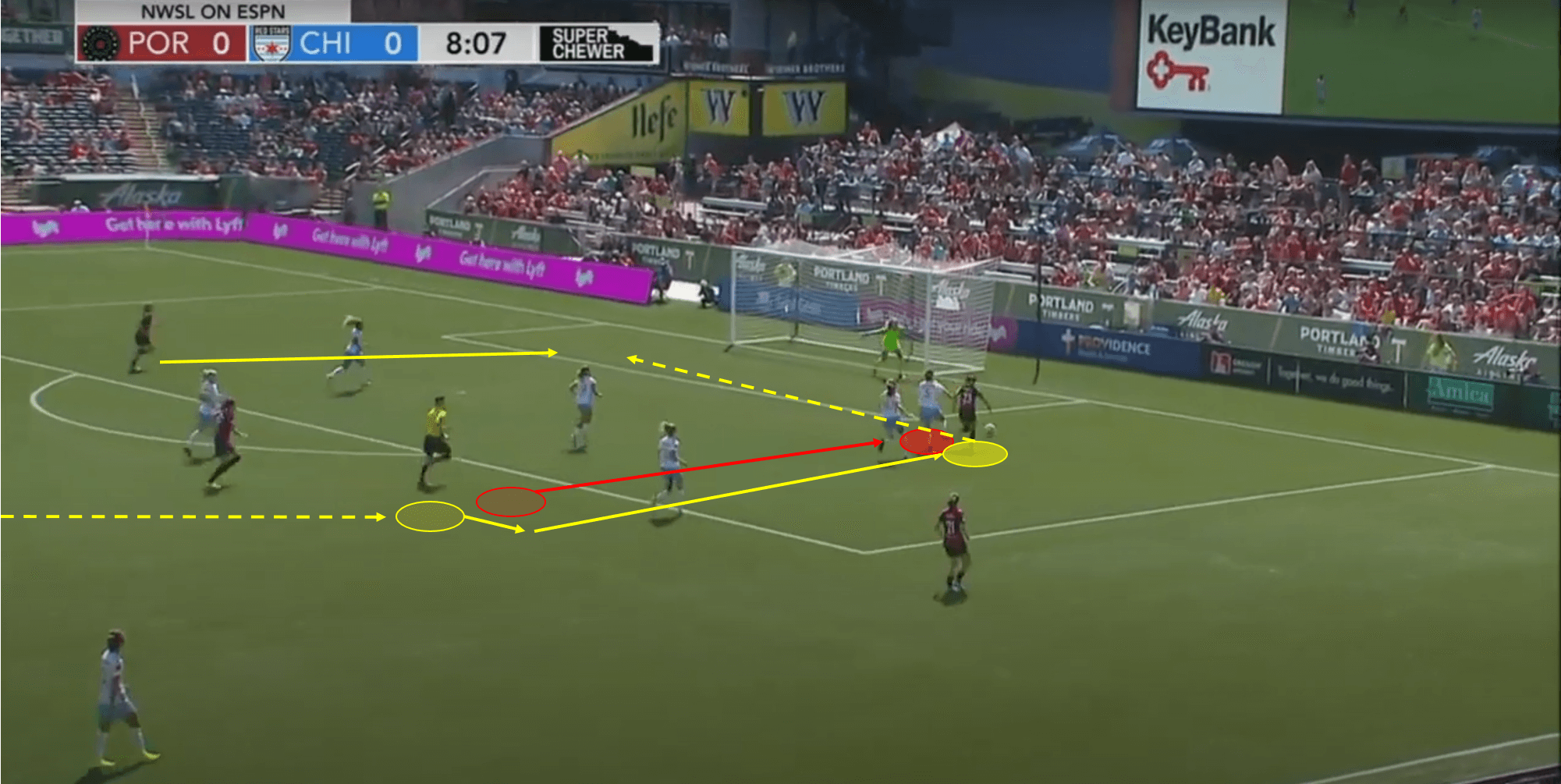
Purce is then able to penetrate forward and create a cross for her teammate. It is notable that Purce executed this movement that exposed the ball to the Red Stars centre-back so fast that the defender was not able to react and steal the ball. Purce’s agility and ability with her feet allowed her to escape pressure from behind even though she exposed the ball to the opponent.
In the same match, we also find a moment in which Purce is faced with direct pressure from the front. Purce has received the ball on the left flank and is met with immediate pressure from the Red Stars right-back. Notice in the image below that the Red Stars right-back is using her body angle to show Purce to the flank and is attempting to take away any dribbling access to the halfspace.
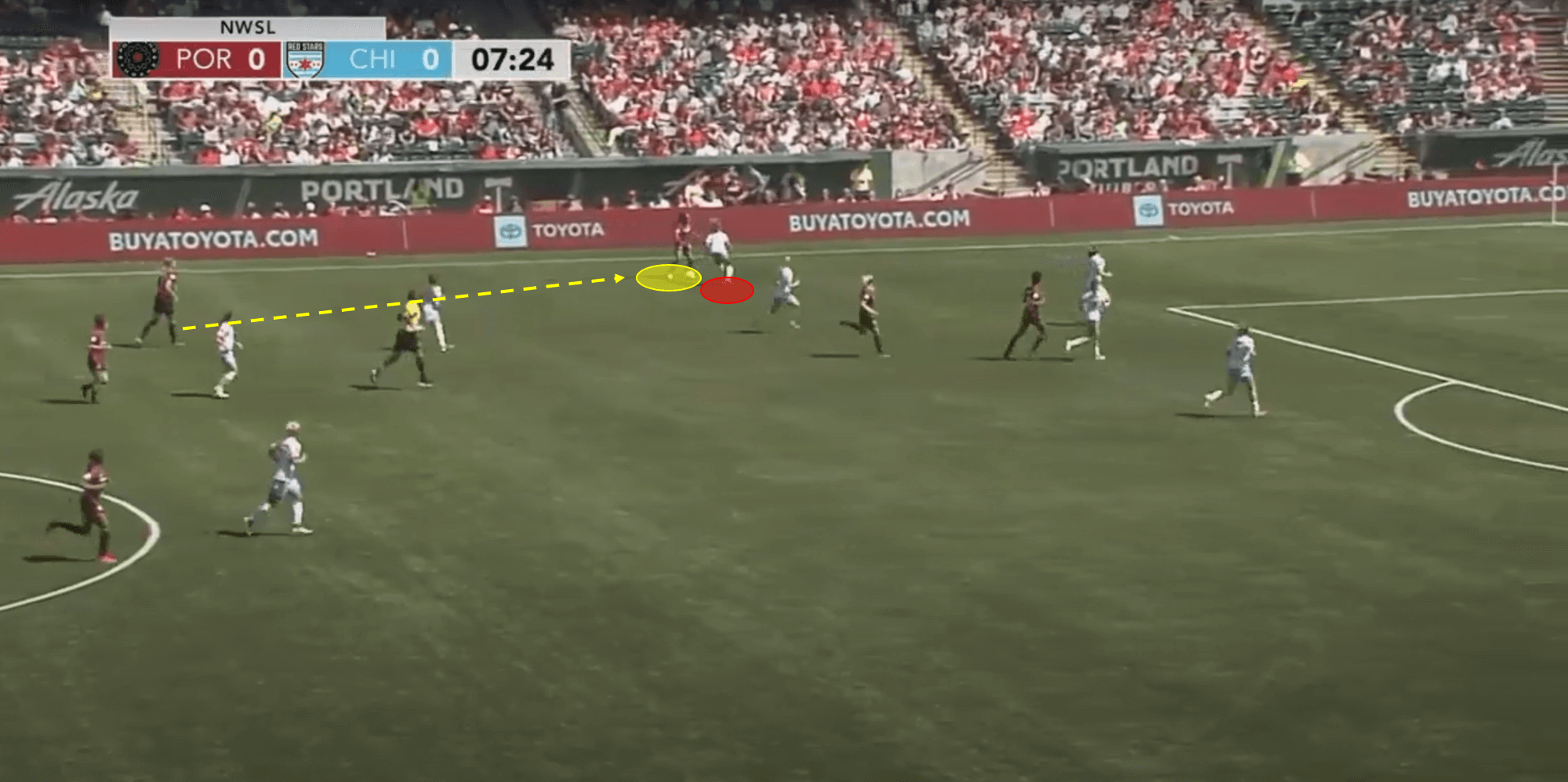
Purce decides to penetrate centrally anyways. She uses the outside of her right foot to push the ball away from her body, drawing the right-back with it. She then uses the inside of the foot to cut back inwards, signalling that her initial movement was a bluff. This cut inwards fully draws pressure from the right-back. As the right-back fully commits to pressuring the inside movement, Purce again uses the outside of her foot to push the ball outside of her body. The right-back is now unbalanced and Purce is able to penetrate past the right-back into open space.
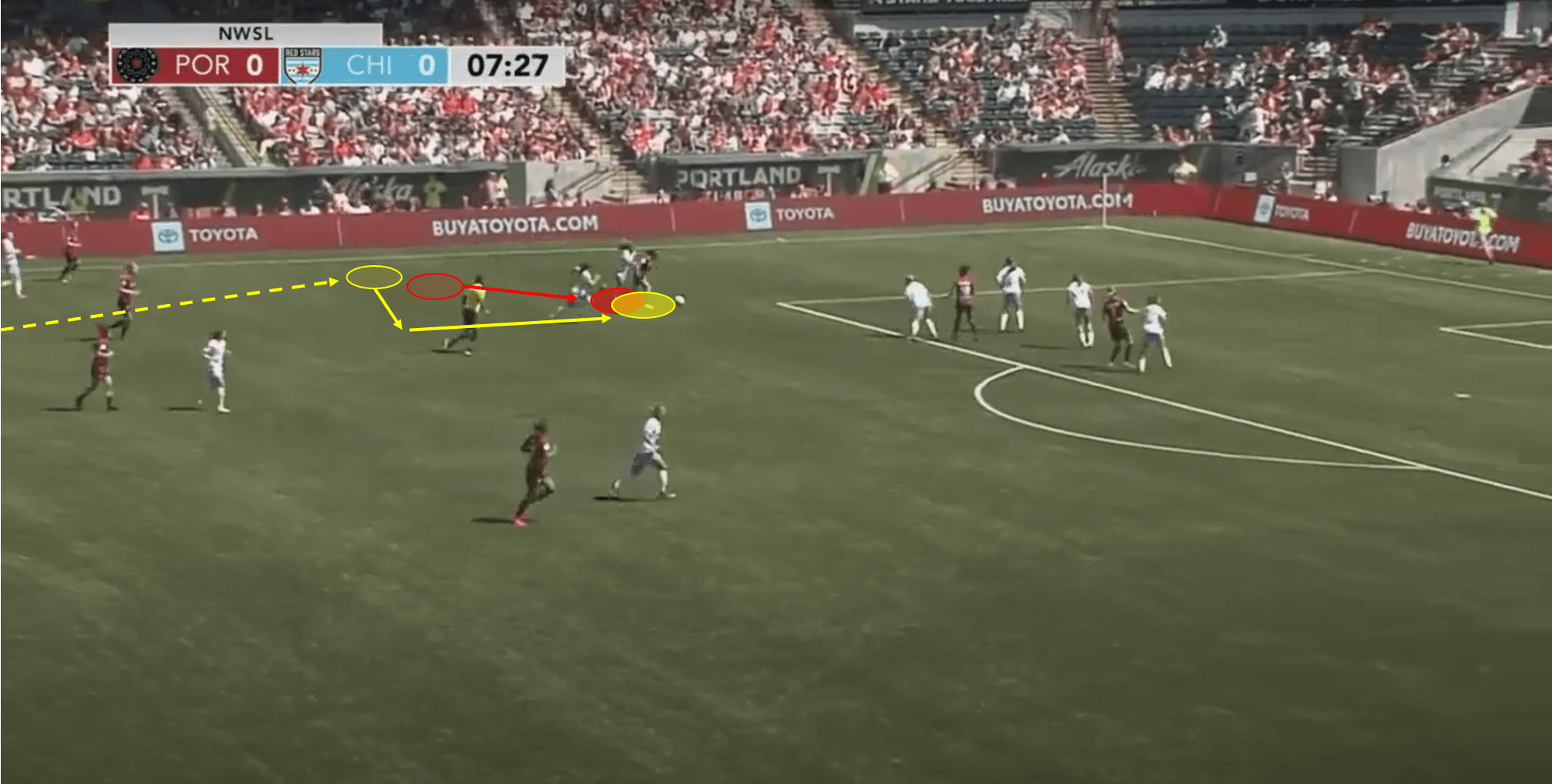
Purce’s use of change of speed and change of direction with all parts of the feet allow her to execute successful 1 vs 1 in various areas of the pitch.
Space finder
In addition to being dynamic and dangerous with the ball at her feet, Purce is also able to perceive and access attacking space in crucial moments throughout the match. This allows her to enter dangerous areas and to receive the ball and does this with her vision and awareness.
Below we see a moment in which Purce uses her positioning to create access to a through ball while simultaneously remaining on her direct opponent’s blindside. Blindside movements might sound like a small detail, but it is not. Studies have shown when people in various scenarios are interrupted and have to switch their attention back and forth, they take on average 50% longer to accomplish their task and make up to 50% more errors.
This comes into play when Purce positions herself on the blindside of her markers. The marker is then forced to switch her vision between the ball carrier in front of her and the off the ball movements of Purce. Purce is more easily able to move into attacking space to create chances on goal because the marker is distracted.
In the image below, Purce aligns herself on the blindside of her opponent and positions herself on the offside line. Because the centre-back’s vision is directed at the Thorns ball carrier as a through pass is released, Purce is able to receive the ball in space behind and put the ball in the back of the net.
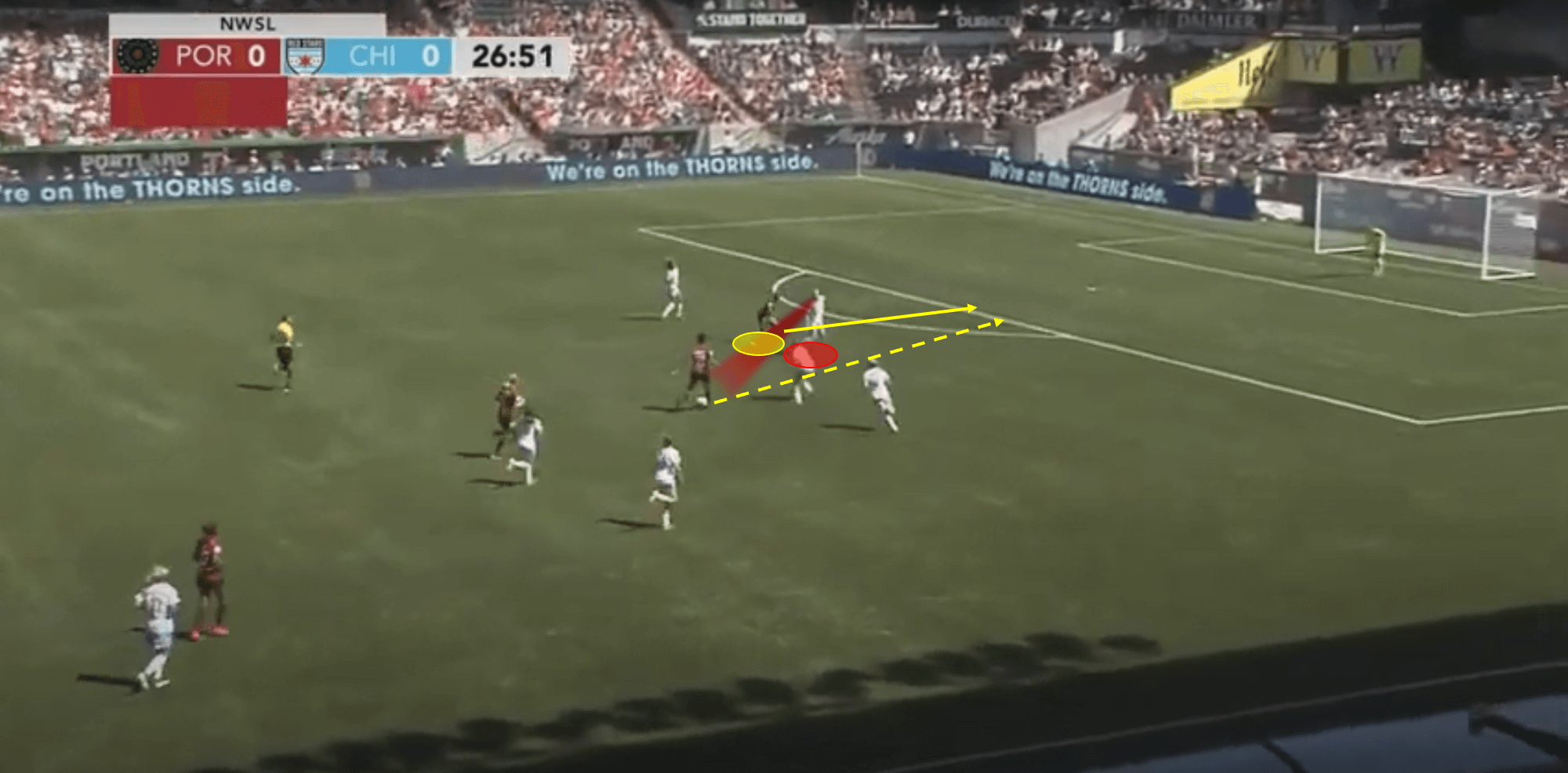
Purce is also cognitively aware of space being created in real-time. This allows her to move into space that will soon be created, giving the effect of her appearing in space out of nowhere.
In a match against Utah Royals, we see a loose ball moving into a space between two Thorns and two Royals players. Initially, all four players move towards the path of the ball in an attempt to recover it. After two steps, Purce realizes that both nearby Royals defenders are moving forward towards the exact same position.
Instead of continuing towards the ball, Purce breaks off to her left towards the Utah defenders.
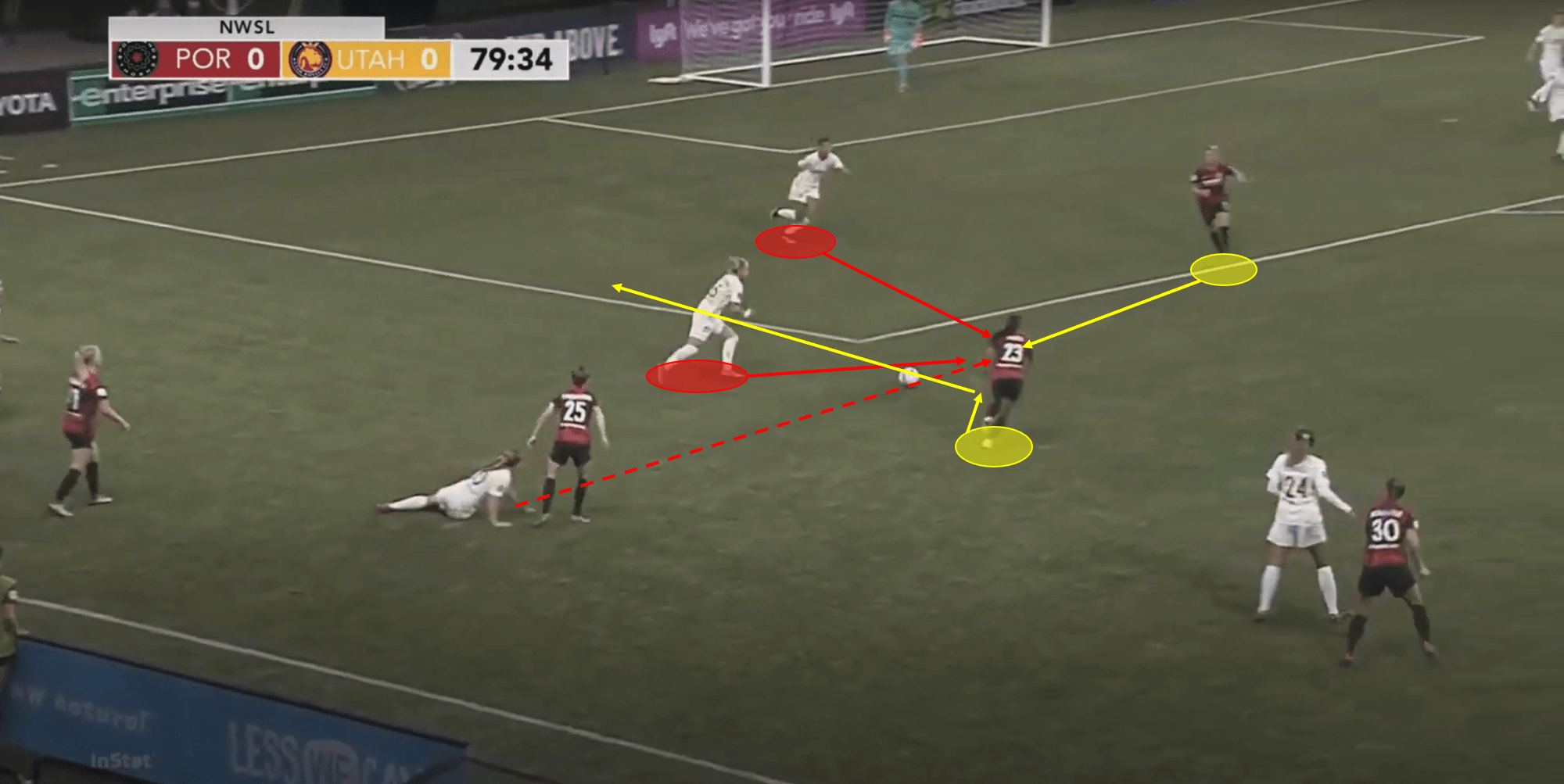
Purce’s teammate is able to reach the ball first and in that moment Thorns now possess the ball with Purce already making an attacking run behind. Her Thorns teammate one-touches the ball into space behind for Purce to run onto nearly unopposed. From there Purce is able to take a few touches forward and release a cross across the box.
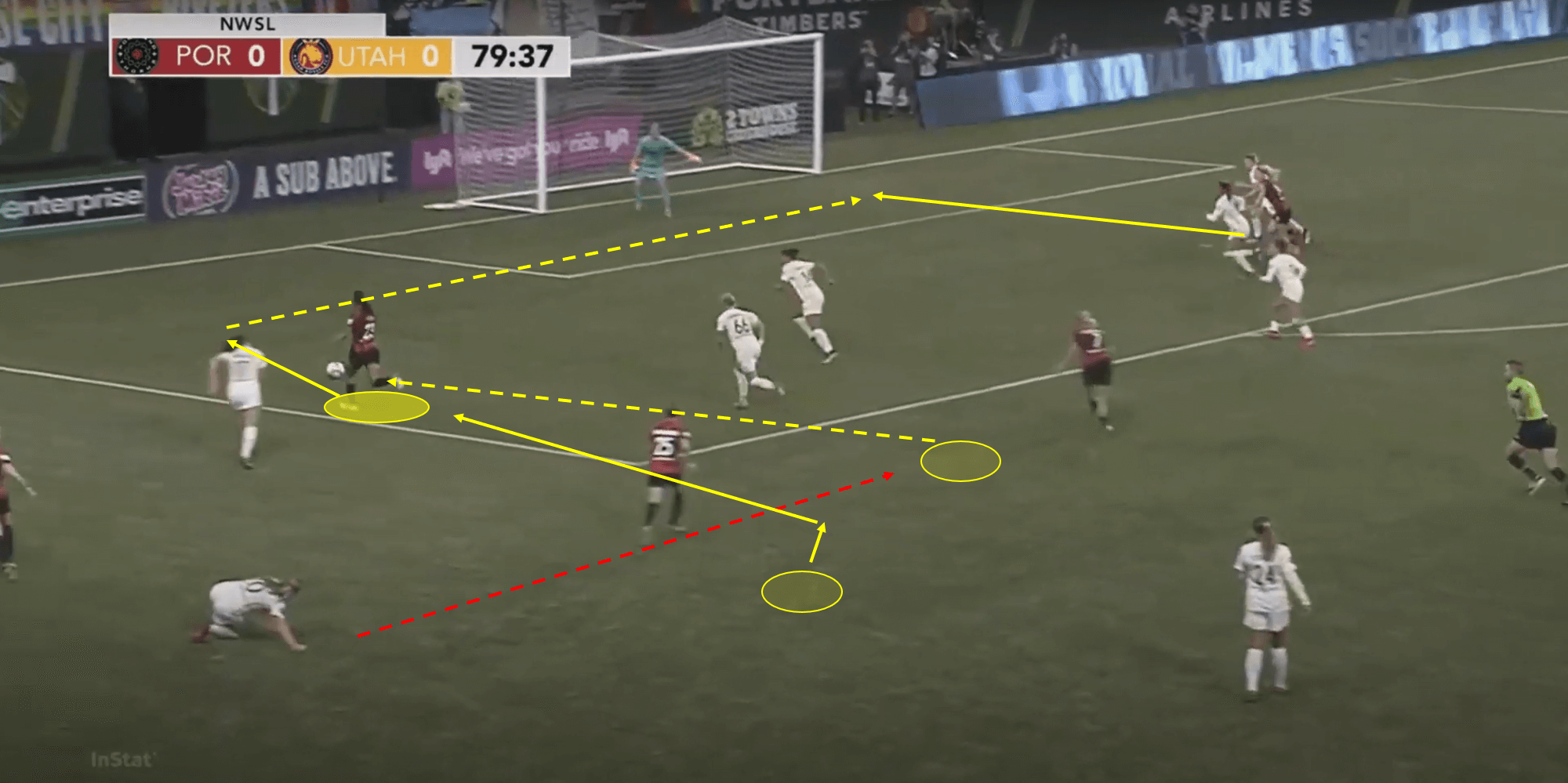
This attacking moment was possible due to Purce observing space about to be created and moving towards it before it existed.
She is not only able to find attacking space while off the ball but with the ball at her feet as well. In the same match against Utah, we find Purce receiving a pass from the left flank while she is positioned in the halfspace.
As the ball is travelling towards her, she takes her eye off the ball and scans the area around her. In her peripheral vision, she sees that she is receiving pressure from behind and that there will be a large amount off space behind the incoming defender.
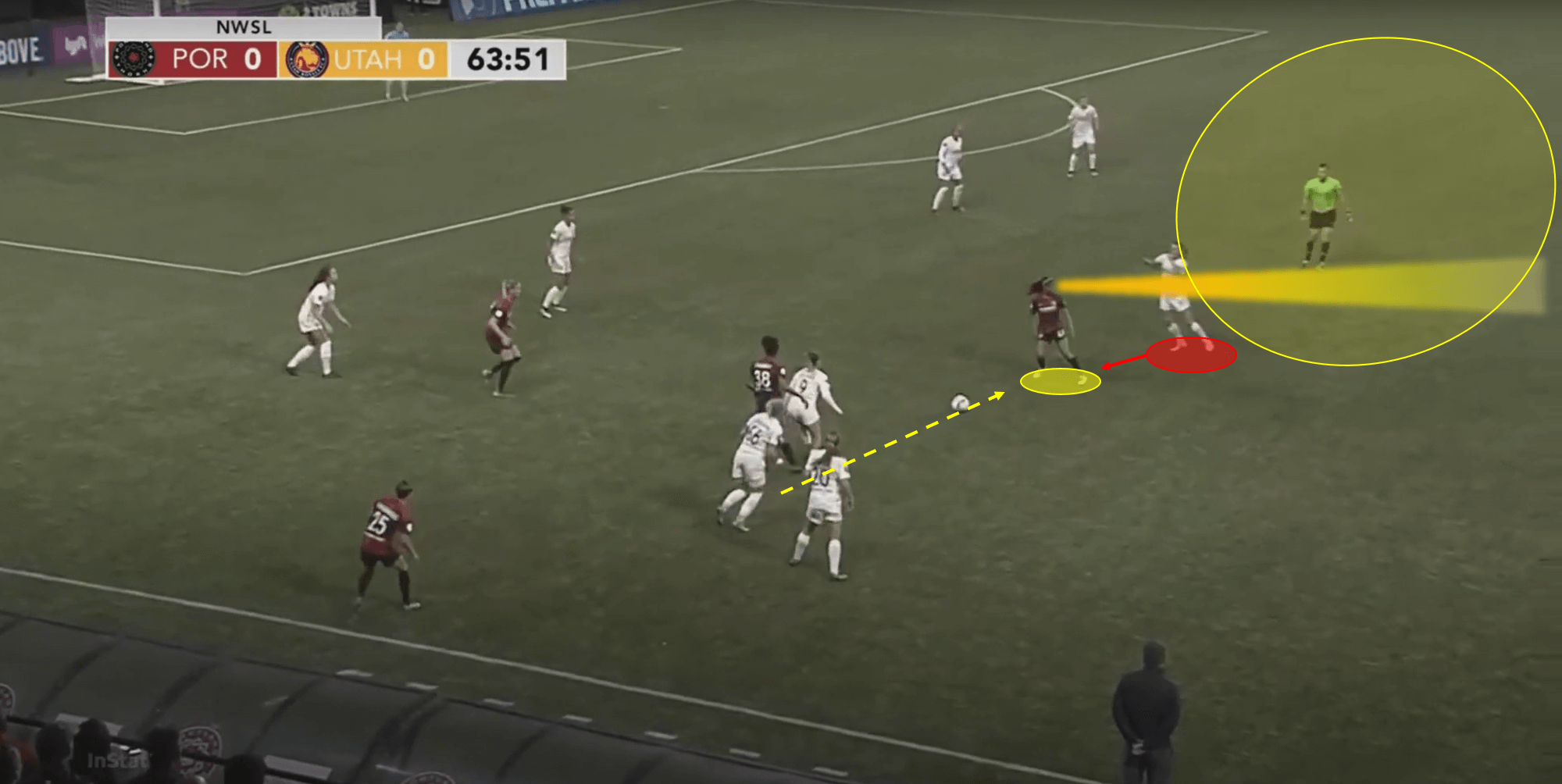
Using a similar move described in her 1 vs 1 with pressure from behind Purce receives the ball with her right foot and pulls it back with the sole of her foot while opening her body to the defender. She then takes a touch towards the centre channel and penetrates towards goal.
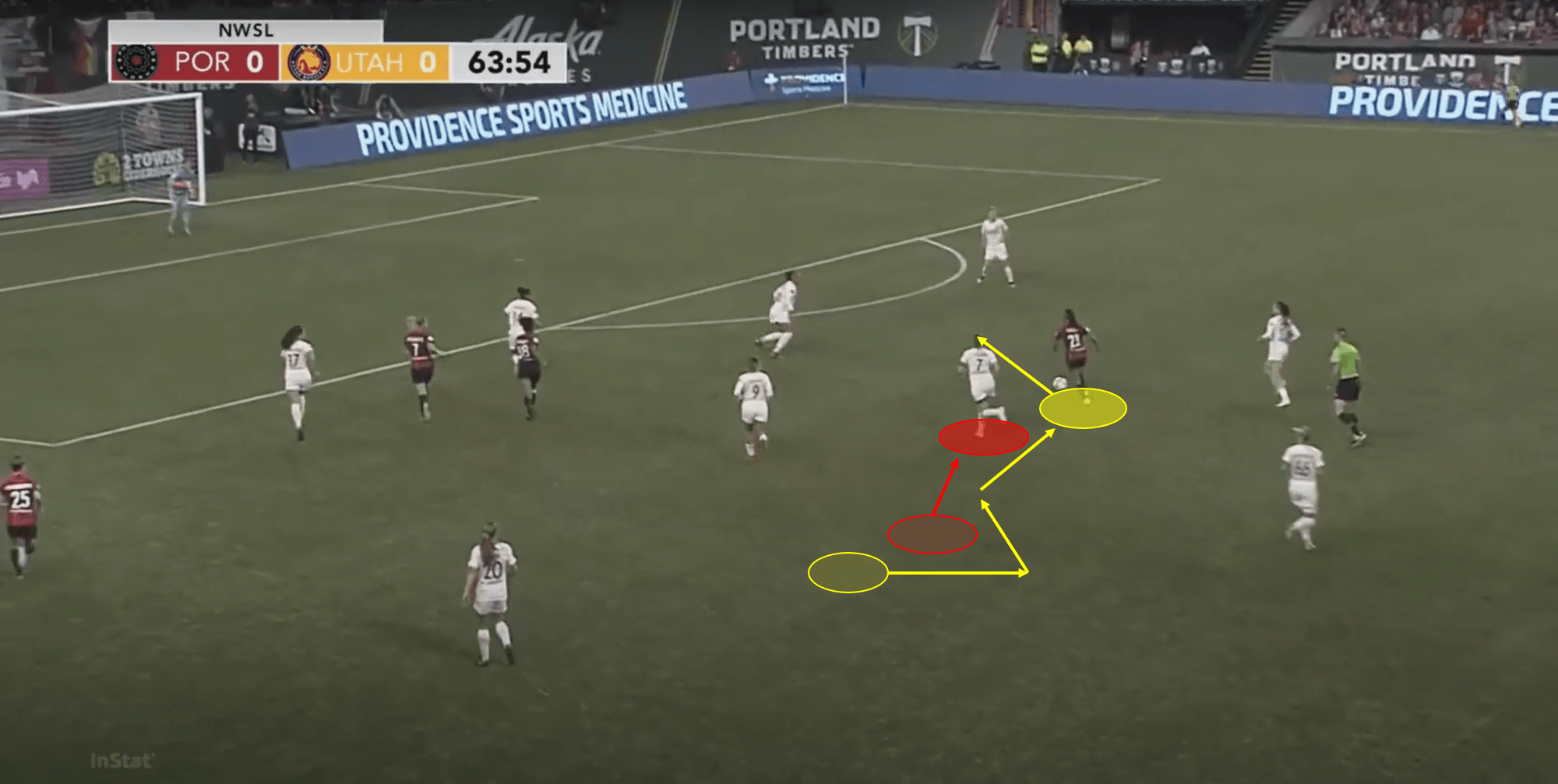
Once again, this movement happens so fast that her direct marker is unable to keep up. The technique to note is Purce’ scanning of the field when receiving the ball. By doing this she takes a snapshot of the area around her and calculates where she wants to go upon receiving the ball.
Purce is able to observe and assess space and soon-to-be-space so quickly that she is able to appear in dangerous areas with quickly and effectively.
Purce with Sky Blue
This brings us to Purce’s arrival to Sky Blue. Freya Coombe immediately moved her from the forward position and began to integrate her into the team tactics as a right-back. Often times we find that players thrive when being able to move to a position/tactical scenario that suits their skillset (i.e. Lukaku: Inter production vs Manchester United production). So at a base tactical level, if Sky Blue can get Purce up the pitch in attack, they should see success. Initially, we did not find Purce engaged in attacks as often as we would have thought and what we found was a slow shift toward more aggressive positioning by Purce as the Challenge Cup progressed.
In the beginning stages of the Challenge Cup we did not find Purce upfield as often as we might think. Below is an average position graph from their first match against Utah.
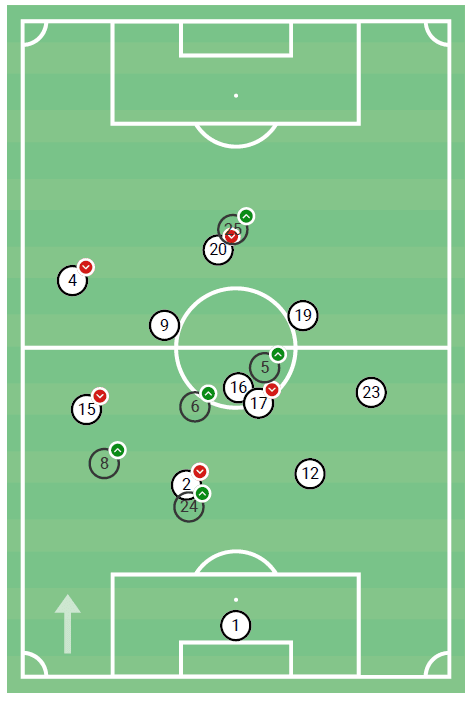
Purce (#23) is found in a relatively deep position for an attacking fullback meant to be included in team attacks. We can see her average position is on the same horizontal line as midfielders Sarah Woldmoe (#16) and Domi Richardson (#17) who interchange as a single pivot when Sky Blue are in possession.
To use a frame of reference, we can see the passing map of a random match from Manchester City in early 2020. City use a similar tactic in allocating forward player Janine Beckie (#11) as a right-back that aggressively pushes forward in attack. The Cityzens have found much success with this tactic with Beckie being a key contributor in their 2019/20 campaign. Here we see that Beckie’s average position in this match puts her much higher up the right flank.
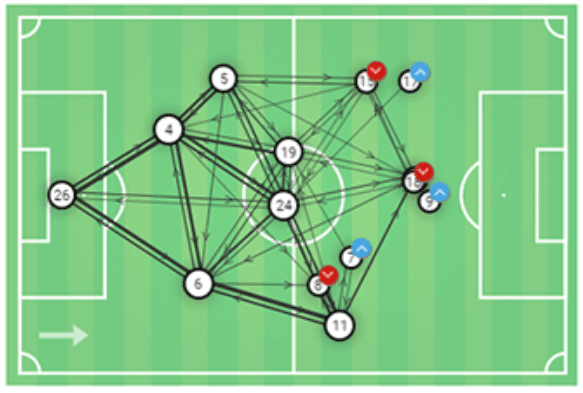
From Purce’s skill set described above, we can see that if Sky blue are able to position her higher up the pitch, she might be able to make a larger impact in attacking tactics during matches. Throughout the Challenge Cup, we slowly saw Purce’s average position move up the right side of the pitch.
Below we see that average position graph from Sky Blue’s quarter-final win against Washington Spirit. We can see that Purce’s position is now in the attacking half of the pitch and much closer to the forward line.
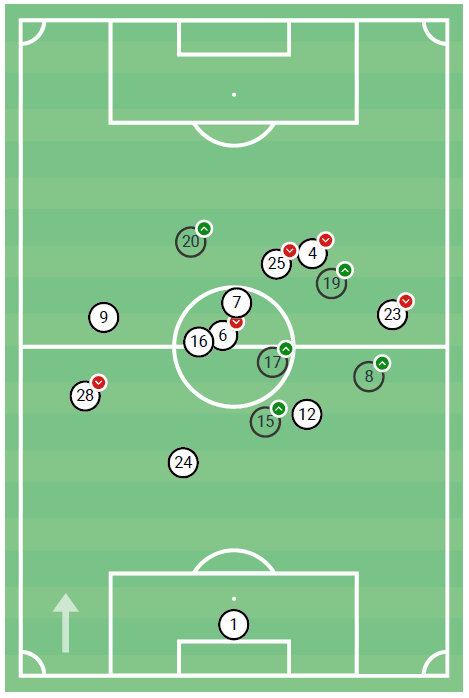
In Sky Blue’s semi-final match against Chicago, we saw much more use of Purce in attacking movements. When in possession Sky Blue would either switch to a back three or have Zerboni drop into the backline. Either way, this movement would release Purce to move up the pitch into more of an attacking position. As this movement occurred in the backline, right-side attacker Paige Monaghan would drift high into the halfspace to drag the Red Stars left-back with her.
Purce’s movement forward creates a dilemma for opponent back lines. If the left-back stays wide to maintain access to Purce, Monaghan’s inward movement is ignored and a 2v2 situation is created on the backline. As we can see in the image below, teams will usually track the inward movement of Monaghan and allow Purce to have this space.
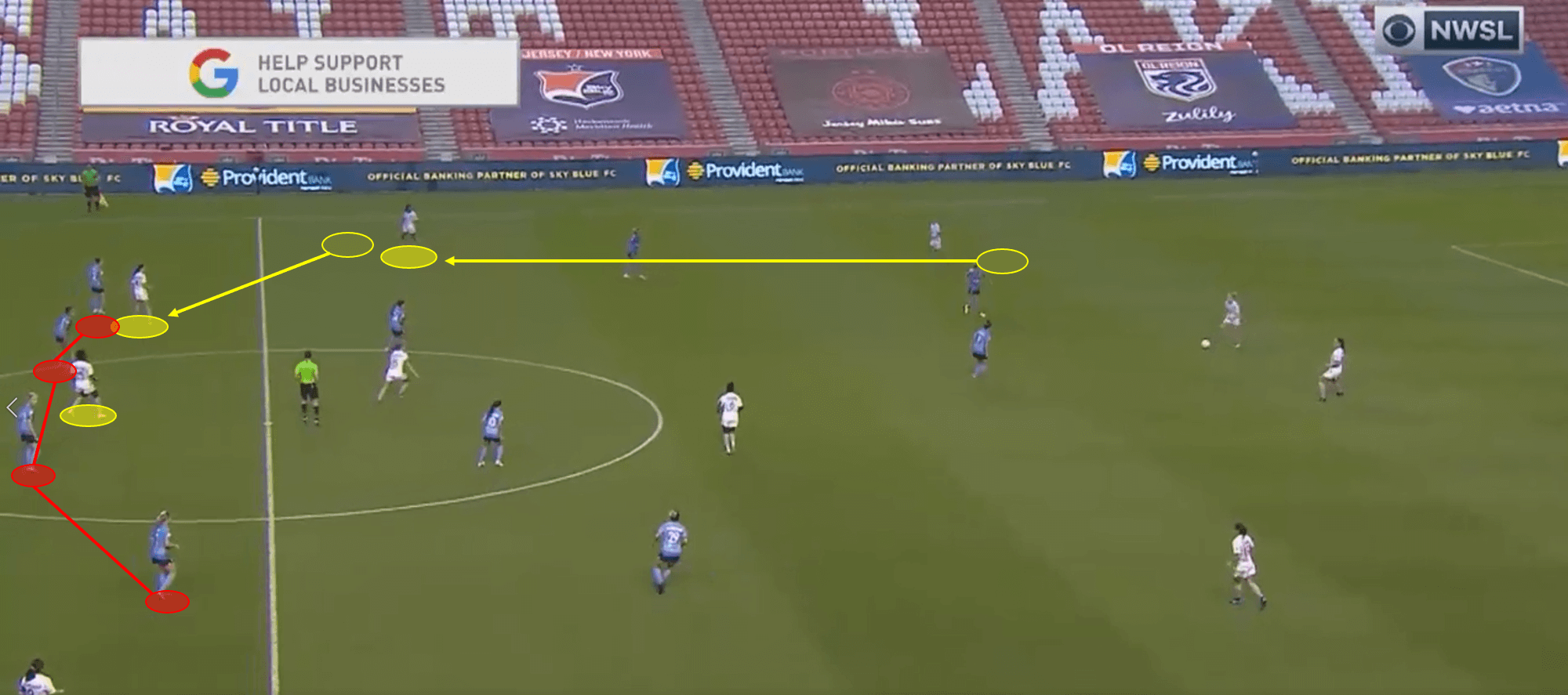
Purce’s involvement in attack helped Sky Blue to create their final goal of the tournament. Purce received the ball on the right flank and was able to bypass both a Chicago midfielder and defender to penetrate into the box. Once in the box, she released a low cross that deflected off the feet of Julie Ertz and found the back of the Chicago net.
Because we saw Purce’s attacking involvement grow with each match Sky Blue played in the Challenge Cup, we must wonder if Purce will become a more consistent force in the team’s attacking tactics.
Conclusion
Unfortunately, as Purce seemed to be finding her attacking groove within Sky Blue’s tactics the COVID-19 affected season came to an end. Sky Blue fans should be looking forward to the next campaign and what Purce will be able to offer the team as an attacking asset.





Comments